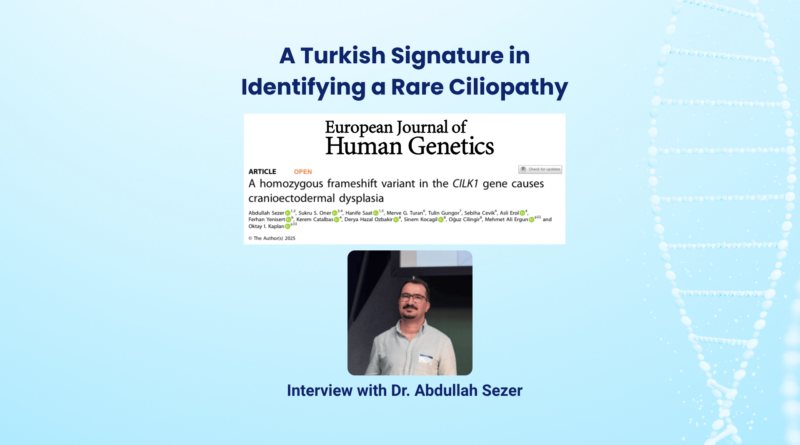Interview with Dr. Abdullah Sezer: A Turkish Signature in Identifying a Rare Ciliopathy
A new study published in the European Journal of Human Genetics has shown that a mutation in the CILK1 gene causes a rare disease called cranioectodermal dysplasia (CED). The study, conducted by a team of entirely Turkish researchers, revealed that this mutation caused the disease in five patients. The study provides a significant finding, demonstrating that not only the proteins involved in cilia structure but also the proteins that regulate them can cause this rare disease.
We spoke with Dr. Abdullah Sezer, a Medical Genetics Specialist at Ankara Etlik City Hospital and one of the authors of this important study, about the details of the research.
***
Can you briefly introduce yourself?
I am Dr. Abdullah Sezer, a Medical Genetics Specialist. I completed my residency in the Department of Medical Genetics at Gazi University Faculty of Medicine in 2021. I have been working at Ankara Etlik City Hospital since 2023. In addition to my clinical duties, I conduct research in the field of rare diseases. I specifically focus on skeletal diseases, skin diseases, and syndromes that cause cognitive impairment.
How did you meet the patients whose diagnoses you explore in your article? How did the diagnostic process proceed?
Our first patient was a 3-4-year-old child who was being monitored in the nephrology unit for kidney failure. He was referred to us because his symptoms suggested a genetic syndrome. Based on the patient’s symptoms, we suspected he had cranioectodermal dysplasia (CED) and conducted the necessary molecular analyses. However, these analyses found no mutations in known genes previously associated with CED, but we did identify a new alteration in a gene called CILK1.
When we examined cousins in the family with similar findings, we found they also carried the same mutation. Thus, we confirmed the same genetic alteration in four individuals from the same family tree. Later, we learned that our colleagues at the Department of Medical Genetics at Eskişehir Osmangazi University had also found the same mutation in another patient, and we decided to collaborate with them.
Before diagnosis, these patients had been followed in various departments (nephrology, gastroenterology, metabolism, neurosurgery, etc.) and even underwent challenging procedures such as liver and kidney biopsies. The correct diagnosis avoided unnecessary procedures, and families received appropriate genetic counseling.
What is Cranioectodermal Dysplasia (CED)?
CED is a rare genetic disorder, also known as “Sensenbrenner syndrome.” It derives its name from abnormalities in the head (cranio) shape and ectodermal tissues (skin, hair, teeth, nails). Besides these external symptoms, the most serious aspects of the disease are involvement of internal organs such as liver and kidney failure, and growth retardation.
CED belongs to a group of diseases called “ciliopathy.” Cilia are caused by the malfunction of the eyelash-like structures called “cilia” on the surface of cells. Cilia play a critical role in intercellular communication, sensory perception, and organ development. Therefore, a defect in cilia can lead to systemic diseases affecting many organs. CED is one of the relatively milder members of this group.
So, what is the function of the CILK1 gene, and what exactly was discovered in this study?
CILK1 encodes an enzyme called ciliogenesis-associated kinase 1. This enzyme is a protein that limits the length of cilia in cells and regulates the localization and delivery of cell signaling molecules to the correct destination. In other words, CILK1 encodes a regulatory protein, not a structural protein.
Mutations in the catalytic domain of this gene were known to cause fatalities in the womb or in newborns. However, we have shown for the first time that a mutation in the non-catalytic domain produces a milder form compatible with life. We have also demonstrated that CED can arise not only from mutations in structural proteins but also from defects in regulatory proteins.
What experimental studies were conducted to demonstrate that this mutation actually causes disease?
To support our findings, we conducted functional analyses in both patient cells and model organisms. First, we examined cilia structure and function under a microscope in cells obtained from skin biopsies taken from patients. In these cells, we observed significant defects in the length and number of cilia, as well as abnormalities in protein transport. We then tested whether these defects were corrected by exogenously adding the healthy (non-mutated) CILK1 gene to the cells, and indeed, we found that function returned to normal.
In addition, we genetically mimicked the same mutation in a transparent worm model, C. elegans. These experiments, conducted in the laboratory of Dr. Oktay Kaplan at Abdullah Gül University, yielded results consistent with those observed in patients. This strongly confirmed that this mutation in the CILK1 gene causes loss of cilia function.
How were these findings added to the OMIM database?
OMIM is an international database that contains and categorizes genetic disease information and is considered a primary reference. If a new gene-disease association is supported by strong evidence, it is included here. Because the genetic, clinical, and functional findings in our study are consistent, this variant in the CILK1 gene and its association with CED disease have been included in OMIM.
What is the significance of this study?
This research has provided a new perspective by demonstrating that not only structural proteins, but also regulatory proteins can cause disease in the CED group of ciliopathies. Because CILK1 is an enzyme, it may be possible to modify its function with small molecules in the future, thus identifying a potential target for the treatment of this group of diseases.
Furthermore, this study was conducted entirely in Turkey, thanks to the efforts of local teams from four national universities and Ministry of Health hospitals. This is a source of particular pride for us.
***
The findings of Dr. Abdullah Sezer and his colleagues constitute a significant milestone both in the diagnosis and elucidation of the mechanisms of rare diseases and in the identification of new therapeutic targets. We congratulate the entire team on this achievement.
We hope this success story from Turkey will inspire young researchers. We thank Dr. Sezer for sharing his experience with us.
You can access the full publication via the link: https://www.nature.com/articles/s41431-025-01902-0

